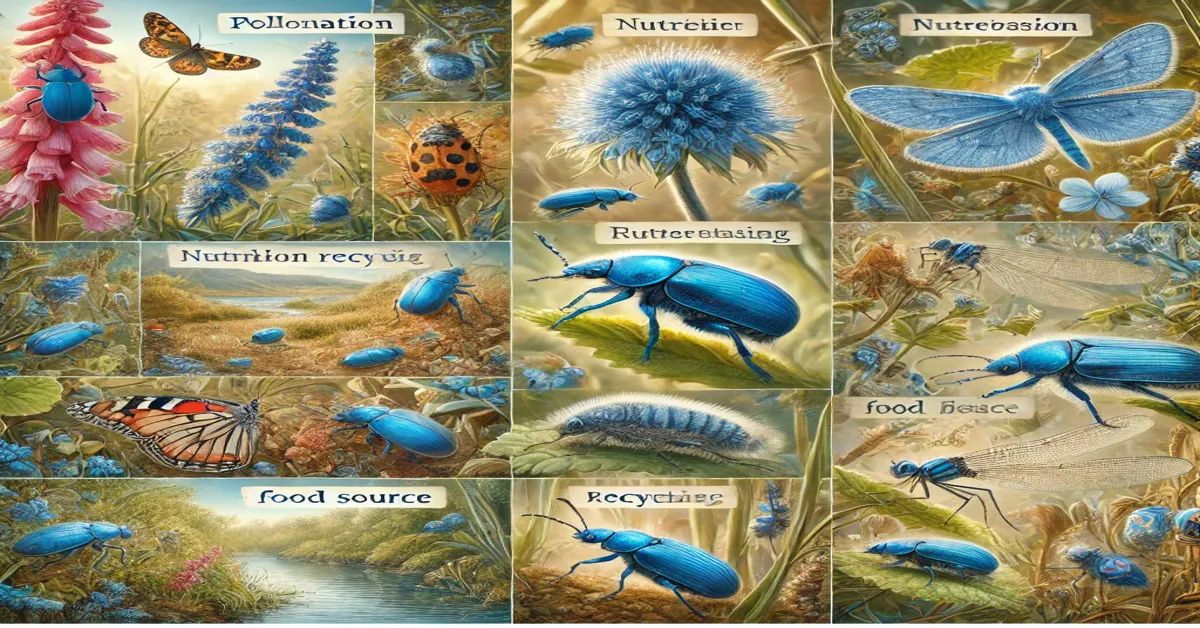Bugs and insects play an essential role in maintaining ecological balance, and some stand out not only for their functions but also for their unique colors. Blue bugs are among these eye-catching creatures, fascinating both scientists and nature enthusiasts. While “blue bugs” is a broad term that encompasses various species across different orders and families, it often refers to insects that exhibit a striking blue color, whether due to pigmentation or structural coloration. Examples of blue bugs include blue beetles, blue damselflies, and the blue carpenter bee. Their distinctive color, adaptive traits, and ecological roles make blue bugs important players in ecosystems around the world.
This article explores the world of blue bugs, examining the unique adaptive mechanisms that give them their color, their ecological roles, preferred habitats, interactions with other species, and the environmental challenges they face. By understanding the environmental niche of these blue-hued insects, we can gain insights into their contributions to biodiversity, their roles in pollination, pest control, and ecosystem stability, and the threats they face in rapidly changing environments.
What Makes Bugs Blue?
The blue coloration in bugs can arise through different mechanisms, typically involving either pigmentation or structural coloration. This color serves various purposes, from camouflage to warning signals, and can influence how blue bugs interact with their environment.
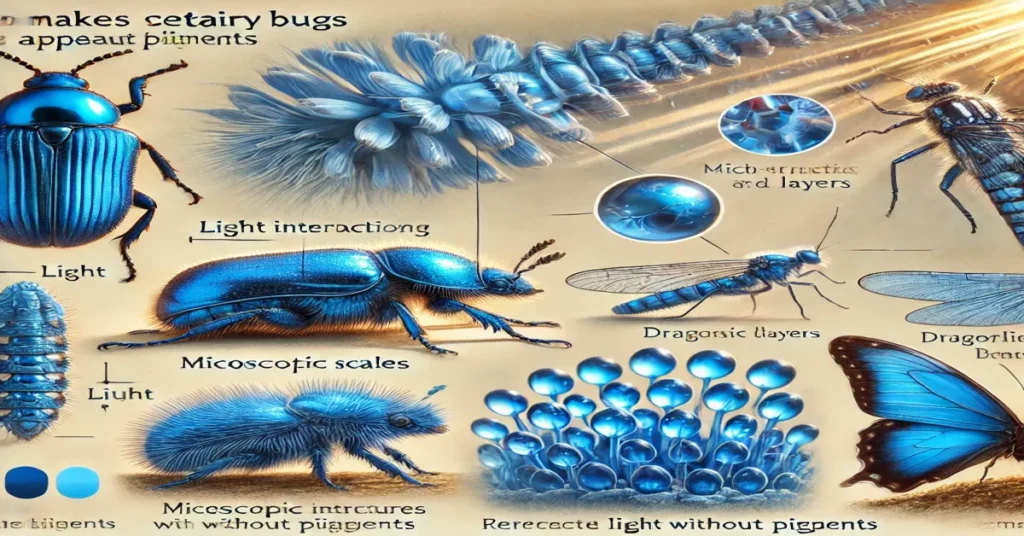
1. Pigmentation vs. Structural Coloration
In many insects, blue coloration is not caused by pigments in their skin or shells but rather by a phenomenon known as structural coloration. Structural coloration occurs when microscopic structures within the bug’s body reflect and refract light, creating colors without pigments. These structures manipulate light in a way that causes it to reflect certain wavelengths—such as blue—resulting in the bug’s iridescent appearance. Many beetles, damselflies, and butterflies exhibit this form of coloration.
Some bugs also contain pigments that naturally produce a blue hue, although this is less common in insects than structural coloration. Pigments are usually organic molecules that absorb specific wavelengths of light, leaving other wavelengths (like blue) visible to the human eye. Pigmented coloration tends to be more stable and does not shift depending on light conditions, unlike the iridescent hues caused by structural coloration.
2. Adaptive Significance of Blue Coloration
The blue color of certain bugs has evolved due to its various adaptive benefits. In some species, such as damselflies, blue coloration may help with camouflage, blending into the sky or water surface to evade predators. For other bugs, such as the blue milkweed beetle (Chrysochus cobaltinus), blue serves as a warning signal to potential predators about the presence of toxins, deterring animals that might otherwise prey on them.
Blue coloration can also play a role in mating and territorial displays, particularly among species like the blue carpenter bee (Xylocopa caerulea) and some damselflies. In these insects, vibrant blue hues help individuals stand out, attracting mates or warning rivals. These adaptive uses of color show how blue bugs have evolved specific visual traits to enhance their survival and reproduction within their environments.
Examples of Blue Bugs and Their Ecological Roles
The term “blue bugs” encompasses a wide range of species, each occupying a distinct ecological niche and playing a specific role within its habitat. Below are some notable examples of blue bugs and the contributions they make to ecosystems.
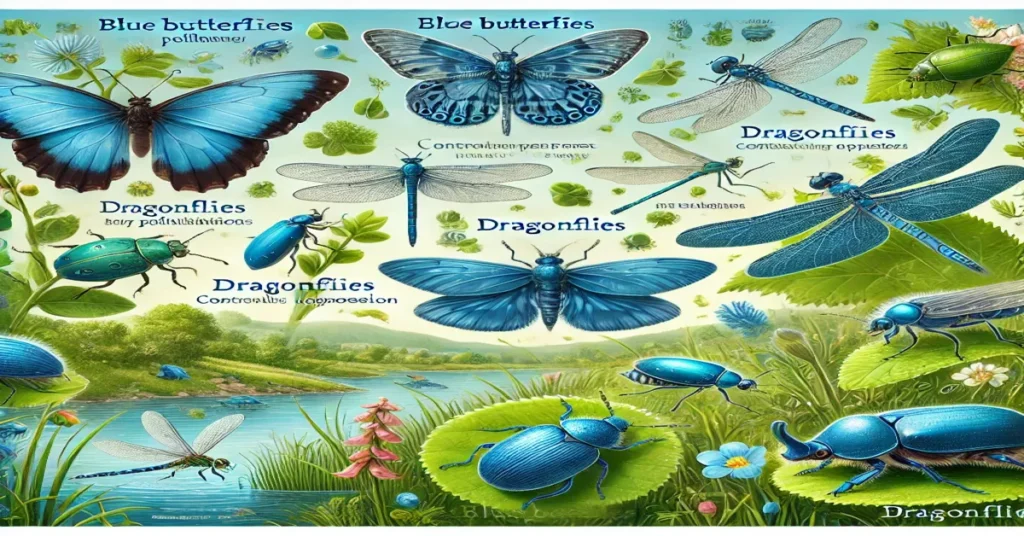
1. Blue Damselflies (Calopteryx spp.)
Damselflies are delicate, slender-bodied insects often found near water sources like ponds, lakes, and rivers. The striking blue color of some species, such as the azure damselfly (Coenagrion puella), helps them blend into their aquatic surroundings and attract mates. Damselflies are predatory insects that feed on small invertebrates, such as mosquitoes, flies, and other pests, making them important for natural pest control.
Ecological Role: As predators of smaller insects, damselflies help control populations of pests that might otherwise disrupt ecosystems or spread diseases. Their larvae, which are aquatic, also play a role in water-based food webs, serving as prey for fish and other aquatic animals.
2. Blue Milkweed Beetle (Chrysochus cobaltinus)
The blue milkweed beetle, native to North America, feeds primarily on milkweed plants. Its vibrant blue color serves as a warning to potential predators, signaling the presence of toxins absorbed from milkweed leaves. These toxins make the beetle unpalatable, helping it avoid predation.
Ecological Role: Blue milkweed beetles play a role in the food chain, serving as prey for specialized predators that can tolerate or detoxify milkweed toxins. Additionally, by feeding on milkweed, they help manage the growth of these plants, contributing to a balanced ecosystem.
3. Blue Carpenter Bee (Xylocopa caerulea)
The blue carpenter bee is native to parts of Southeast Asia and is known for its stunning metallic blue coloration. Carpenter bees are important pollinators, feeding on the nectar and pollen of various flowers. As pollinators, they play a crucial role in plant reproduction and biodiversity.
Ecological Role: By transferring pollen from one plant to another, blue carpenter bees support plant diversity and reproduction. Their pollination services are essential for maintaining healthy plant populations, which in turn support other organisms in the ecosystem. These bees also contribute to soil aeration by burrowing into wood, allowing for improved soil health around their habitats.
4. Blue Morpho Butterfly (Morpho menelaus)
Although butterflies are not typically classified as “bugs,” they are still part of the insect family and share similar ecological roles. The blue morpho butterfly, native to Central and South America, is one of the most iconic blue insects, known for its large, iridescent wings. The butterfly’s bright blue color helps deter predators by confusing them as the butterfly’s wings appear to change color when in motion.
Ecological Role: Blue morpho butterflies contribute to pollination as they feed on nectar, although they are not as efficient as bees. Their larvae, which feed on plant leaves, help in nutrient cycling, while adult butterflies serve as prey for birds and other predators, adding to the food web dynamics of their habitats.
5. Blue Jewel Beetle (Chrysochroa fulgidissima)
The blue jewel beetle, or metallic wood-boring beetle, is native to Japan and other parts of East Asia. Its iridescent blue and green coloration is an example of structural coloration. These beetles often lay their eggs in dead or dying trees, where their larvae feed on the wood as they grow.
Ecological Role: As wood-boring insects, jewel beetles play an essential role in forest ecosystems. By breaking down dead wood, they contribute to the decomposition process and nutrient cycling, returning essential nutrients to the soil. This process supports plant growth and forest health, making them a critical part of forest ecosystems.
Preferred Habitats of Blue Bugs
Blue bugs are distributed across a variety of habitats, each suited to their specific environmental needs and survival strategies. These insects are often found in areas rich in vegetation, water, or decomposing organic material, as these conditions provide abundant food sources and protection from predators.
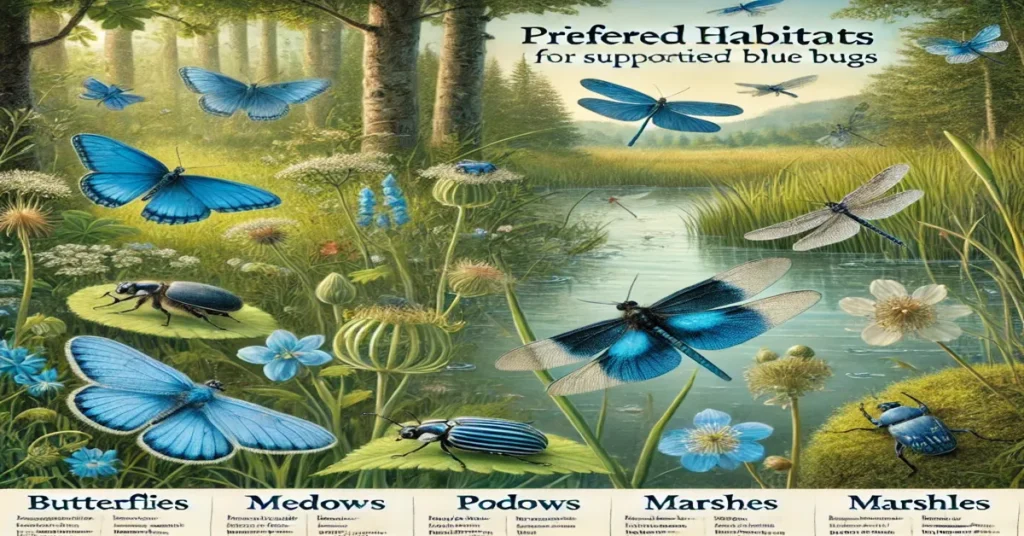
1. Aquatic and Semi-Aquatic Environments
Many blue insects, like damselflies, are closely associated with aquatic environments, where they spend part of their life cycle. Bodies of water provide an essential habitat for these insects, as their larvae are aquatic and require specific conditions to thrive. These environments are also rich in prey, such as mosquitoes and other small insects, supporting the dietary needs of blue damselflies and similar species.
2. Forested and Woodland Areas
Forests and woodlands provide diverse habitats for blue bugs such as blue carpenter bees and jewel beetles. These areas are rich in flowering plants, decaying wood, and sheltered nesting sites, making them ideal for insects that rely on flowers for nectar or wood for nesting and food. The variety of plants and trees in forests also supports a high degree of biodiversity, enabling blue bugs to interact with a wide range of other species.
3. Meadows and Grasslands
Grasslands and meadows are home to blue bugs like blue milkweed beetles, which rely on native plants like milkweed for sustenance. These open habitats are rich in plant diversity and support numerous insect species, offering ample resources for herbivorous and pollinating bugs. Grasslands also provide visibility, reducing the risk of predation for brightly colored insects like the blue milkweed beetle.
4. Tropical Rainforests
Tropical rainforests, particularly in South and Central America, are home to blue morpho butterflies and various blue beetles. The high humidity, consistent temperatures, and abundant vegetation provide ideal conditions for these insects, which rely on the dense foliage for food and shelter. Rainforests’ biodiversity and complexity support numerous ecological niches, allowing blue bugs to thrive alongside other species.
Ecological Roles and Interactions of Blue Bugs
Blue bugs play essential ecological roles, from pollination and pest control to nutrient cycling. Their interactions with plants, animals, and other insects contribute to the stability and resilience of ecosystems.
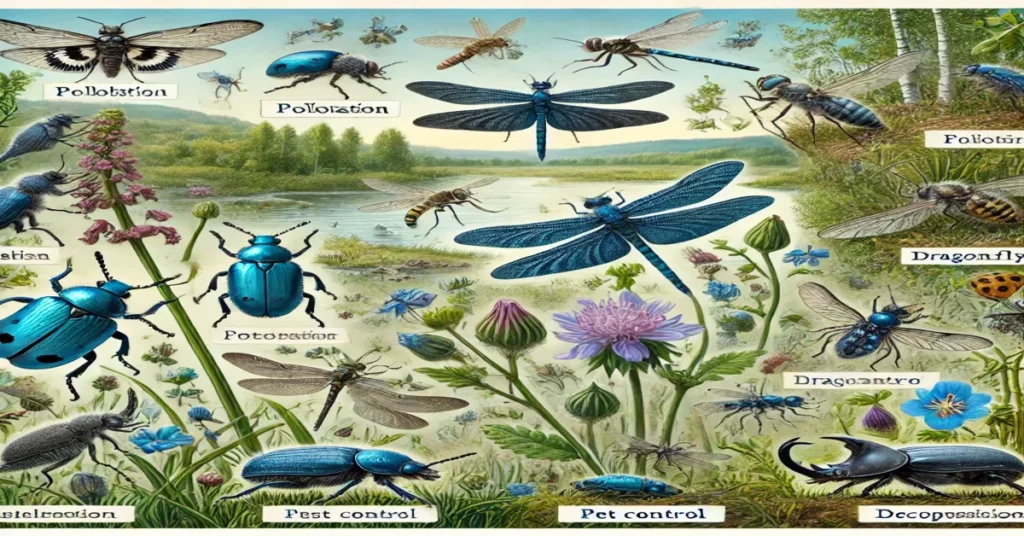
1. Pollination and Plant Reproduction
Insects like the blue carpenter bee play a critical role in pollination, facilitating plant reproduction and contributing to the genetic diversity of plant populations. As they move from flower to flower collecting nectar, they transfer pollen, allowing plants to produce seeds and fruit. Pollination by blue bugs supports agricultural crops, wild plants, and ecosystems that rely on healthy plant populations for food and shelter.
2. Pest Control and Population Management
Blue damselflies are efficient predators of smaller insects, helping to control populations of mosquitoes, flies, and other pests. Their predatory habits contribute to a balanced ecosystem by preventing pest overpopulation, which can disrupt food chains and lead to ecological imbalances. By controlling pest populations, blue bugs help maintain a healthy environment and reduce the spread of insect-borne diseases.
3. Nutrient Cycling and Decomposition
Blue jewel beetles and other wood-boring beetles contribute to decomposition by breaking down dead wood and organic material. This decomposition process returns essential nutrients to the soil, promoting plant growth and supporting healthy ecosystems. Nutrient cycling by beetles and other decomposers is especially vital in forest ecosystems, where dead wood accumulation would otherwise hinder growth and reduce biodiversity.
4. Food Source for Predators
Blue bugs are an important part of the food web, serving as prey for various animals, including birds, reptiles, and mammals. Their bright colors make them easily recognizable, and while some use this to their advantage as a warning signal, others simply blend into the landscape. By providing a food source for predators, blue bugs help sustain biodiversity and ensure energy transfer within ecosystems.
Conservation Challenges for Blue Bugs
Like many insects, blue bugs face a range of conservation challenges, primarily due to habitat loss, climate change, and pollution. Their specialized habitats and ecological roles make them vulnerable to environmental changes, which can have far-reaching effects on the ecosystems they support.
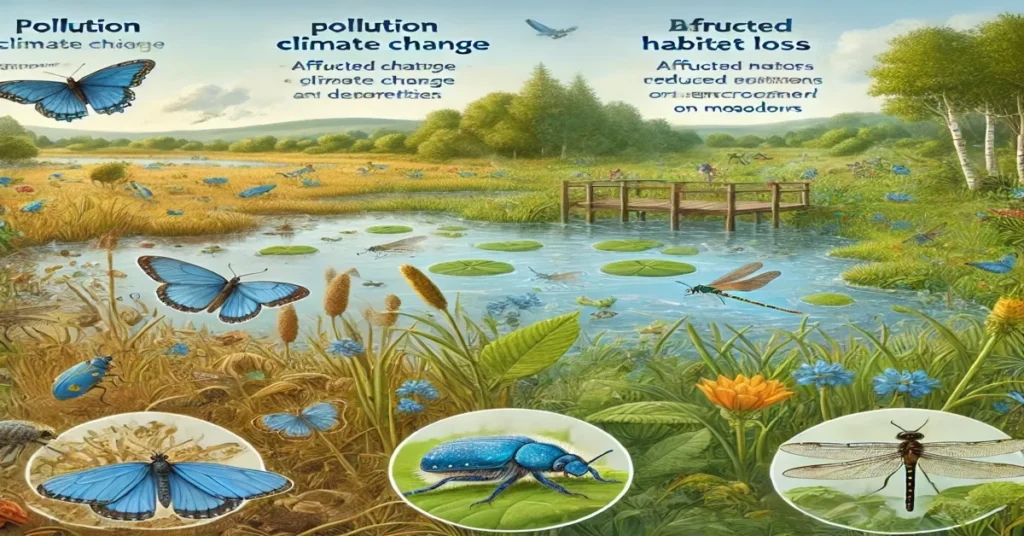
1. Habitat Loss and Fragmentation
Urbanization, agriculture, and deforestation threaten the habitats of blue bugs, reducing the availability of nesting sites, food sources, and shelter. Forest-dwelling species, such as blue jewel beetles and carpenter bees, are particularly affected by habitat loss, as they rely on specific plant communities and dead wood for survival. Habitat fragmentation further isolates populations, reducing genetic diversity and increasing the risk of extinction.
2. Climate Change and Temperature Shifts
Climate change affects blue bugs by altering temperature and precipitation patterns, which can disrupt their life cycles and reproductive behaviors. For example, changes in seasonal temperatures may impact the breeding seasons of damselflies and butterflies, leading to mismatches with food availability. Rising temperatures and shifting weather patterns also affect the availability of water sources for aquatic blue bugs, endangering species that rely on stable aquatic ecosystems.
3. Pollution and Chemical Exposure
Pesticides, herbicides, and pollutants negatively impact blue bugs by contaminating their habitats and food sources. Pollinators like the blue carpenter bee are particularly vulnerable to pesticide exposure, which can affect their health and reduce their populations. Additionally, water pollution affects aquatic blue bugs by degrading water quality, reducing the survival rates of eggs and larvae.
4. Conservation and Awareness Efforts
Conserving blue bugs requires protecting their natural habitats, regulating pesticide use, and raising public awareness about the importance of insects in ecosystems. Habitat restoration, pollution control, and responsible land management can help preserve the environments these bugs need to survive. Educating the public on the roles of blue bugs in pollination, pest control, and nutrient cycling encourages support for conservation efforts that benefit ecosystems as a whole.
Conclusion
Blue bugs are not only visually striking but play crucial roles in their ecosystems. From pollinating plants and controlling pests to contributing to nutrient cycling and serving as food for predators, these insects support biodiversity and ecological stability. However, habitat loss, climate change, and pollution threaten their survival, underscoring the need for conservation and sustainable practices to protect their habitats. By understanding and preserving blue bugs, we support the health of the ecosystems they inhabit and contribute to a more balanced, resilient natural world.
FAQs
1. What types of blue bugs exist?
Blue bugs include various species like blue damselflies, blue carpenter bees, blue jewel beetles, and blue morpho butterflies, each with distinct ecological roles.
2. How do blue bugs get their color?
Most blue bugs get their color through structural coloration, where microscopic structures reflect blue light rather than pigmentation.
3. What is the ecological role of blue bugs?
Blue bugs contribute to pollination, pest control, nutrient cycling, and serve as a food source for predators, supporting ecosystem balance.
4. Where are blue bugs commonly found?
Blue bugs inhabit diverse environments, including forests, wetlands, meadows, and tropical rainforests, depending on the species and their ecological needs.
5. Are blue bugs threatened by environmental changes?
Yes, habitat loss, climate change, and pollution are major threats to blue bugs, impacting their populations and ecological functions.
6. How can we help conserve blue bugs?
Supporting habitat conservation, reducing pesticide use, and promoting awareness of the importance of insects in ecosystems are key steps in conserving blue bugs.
Read More: Tree Bugs: Understanding Their Ecological Role and Environmental Impact

